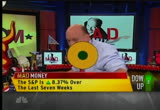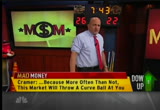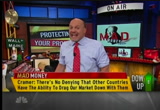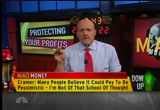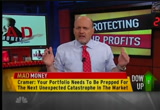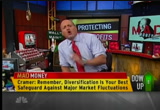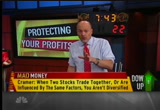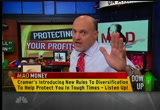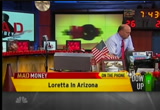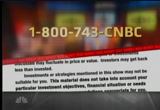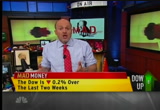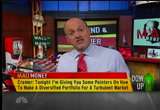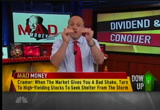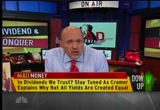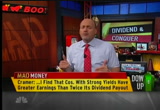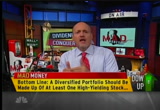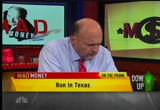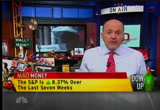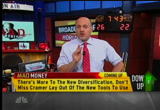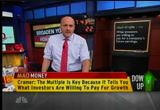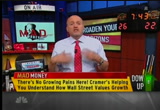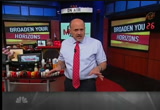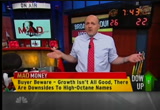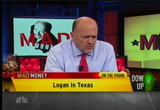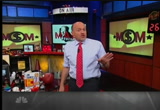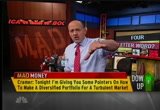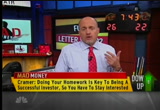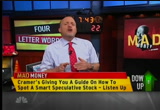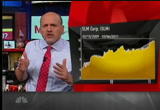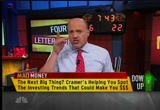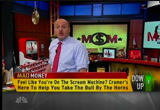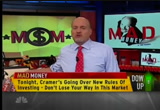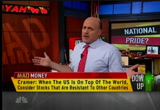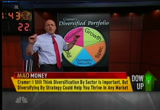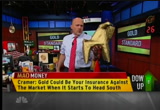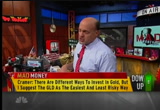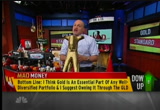tv Mad Money NBC February 16, 2013 3:00am-4:00am EST
3:00 am
♪ spin me right round baby right round like a record, baby ♪ i'm jim cramer, and welcome to my world. >> you need to get in the game! >> firms are going to go out of business, and he's nuts! they're nuts! they know nothing! >> i always like to say there's a bull market somewhere -- >> "mad money." you can't afford to miss it. >> hey, i'm cramer. welcome to "mad money." welcome to cramerica. other people want to make friends. i'm just trying to save you a little money. my job is not just to entertain but i'm trying to educate you. call me, 1-800-743-cnbc. in the face of crushing declines and uproarious rallies and even sometimes just plain jane garden variety days in this market, there's a "mad money" toolbox to help you through and to help you become a better and wealthier investor. tonight i'm cracking it open.
3:01 am
so listen up. if you're going to manage your own money, you have to recognize the value of maybe one of the most important issues out there. the value of humility. so please, repeat after me. sometimes i am going to be wrong. come on. say it. sometimes i'm going to be surprised. and one more. sometimes my stock picks just won't work out. look, i of all people understand that humility doesn't come naturally to everyone. but staying humble, is important. why? because other than greed nothing that's cost people more money than arrogance. if you own stocks, you have to accept the fact that you're going to be wrong, perhaps even often. as the past three years have taught you painfully -- >> the house of pain! >> -- your portfolio will get hit with things you never saw coming, things you never imagined, things you never thought were possible. or to put it another way, the one thing you can be sure of when you're putting a portfolio together is that at some point something is going to go wrong and it will hit you totally out of left field.
3:02 am
or even worse, something bad will happen that could easily have been anticipated unless you took the appropriate precautions you'll end up being run over by a train that you actually saw coming. >> all aboard! >> think about how often have we been clobbered by the mess in europe? every time things start to look less horrible across the atlantic, every time we begin to wonder if maybe, maybe just maybe the worst has finally passed, there's some hideous headline out of greece or portugal or spain or italy. the europe panic comes back with a vengeance, and the s&p 500 gets bashed down by a torrent of selling. that's why it's so important to prepare yourself and your stocks for the next catastrophe around the corner, expected or unexpected, so you can make money in any market, or at least lose less and not just when things are going smoothly. you have to build this stuff into what i call your worldview. you have to assume that somewhere sometime something will go wrong. i'm not saying you should be a super skeptic permabear. not at all.
3:03 am
over the course of my 31-plus years in this business i've seen the averages climb way too high, watched the market make people way too much money to ever be that cynical and closed-minded. being negative all the time has not historically been a lucrative strategy. and i don't see any reason why that should change now. there are a handful of incredibly smart professional short sellers out there. hats off to them. they've been able to reliably turn pessimism into profits. but i don't recommend trying to follow in their footsteps at home. in fact, i never recommend short selling on this show because it's more risky than being long, which is authentic wall street gibberish for owning stocks. it's just a basic question of arithmetic. let's go through it. when you short a stock or bet against it, at best that stock goes to zero and you have 100% gain. double, at worst, it could never stop going higher. and you could lose. 200. 300. 1,000%. you could lose an not finance-it amount of money if you're short. when you own a stock the situation's reversed. the most you could lose is 100% of your money. but you can make much larger gains, quadrupling.
3:04 am
just ask anybody who bought apple back in the bottom of 2009. when it pulled back to less than 100 bucks. if they held on to it for the next three years they snagged a 580% return. >> that was easy. >> i'm not telling you to be so afraid of what could go wrong that you'll pass up on that kind of massive gain. i'm simply saying even if you're incredibly bullish it would be silly to not make sure your portfolio is prepared for the next market-crushing disaster. how many times has europe given and taken away? we know these things happen. we shouldn't let them stop us from trying to make money but we should certainly do what we can to protect our investments in advance. how the heck do you do that? how do you get ready for calamity when you might not even know what it's going to look like? how do you expect the unexpected as an investor? one word. one magic word, diversification. look, diversification, as boring as it might seem, people say jim, i can't make thousands of percent with diversification.
3:05 am
it is the single most important concept in investing. it's the key to avoiding enormous losses and making sure you can stay in the game which is our ultimate goal. that's why we play am i diversified every wednesday, when i talk about this concept ad nauseam. why i call it the only free lunch in the original investing gospel, jim cramer's sane investing in an insane world, why i push it so hard in "getting back to even." if your portfolio is properly diversified, you can handle just about any setback, you can come back from any financial disaster. i mean that. now, normally when i talk about diversification i mean make sure all of your stock eggs aren't in one sector basket like i saw from 2001, 2002, when so many people just left the building because of technology stocks. i go over this again because i can never say it too many times. it means that no one sector, one segment of the economy should ever account for more than 20% of your portfolio. so if you own five stocks, only one could be a tech stock, only one a health care stock, only one a financial, only one can be an energy company only one an industrial and only one can be a food and beverage maker.
3:06 am
what if you're not sure? always err on the side of caution. if two stocks trade together, if the underlying companies succeed or fail based on the same factors, then you're not diversified. an oil driller and oil producer, we often get those on wednesday, people think they're different. they're both part of the same sector. software and hardware, they're both techs, like it or not. i'm not doing this to be arbitrary or capricious or make it more difficult now to pick stocks. these aren't vague technicalities. when you get too concentrated in one area the moment something bad happens one to of those big stocks, you're going to want to throw yourself off a bridge because the losses will be enormous. imagine if you owned too many industrials when the global economy started slowing down because of europe and fast growing economies like china slammed on the brakes with higher interest rates. you got obliterated. how about in if you owned too many banks right before the financial crisis hit? i know a lot of people who did, by the way, because they had such good yields. too many tech stocks going into the dot-com bust. that's where the ruination occurred, something that soured an entire generation of people on investing. spread your money across stocks in unrelated sectors so when something happens that makes one
3:07 am
of them go down hard the rest remain relatively unscathed. sometimes they can even go high per that's your basic diversification. and it is mandatory in cramerica. but you know what? if you're going to be prepared for anything it's not enough to make sure your stocks don't overlap. you need a portfolio that works in all kinds of markets. tonight i want to explain and refine what i like to call the new diversification. how to protect your wealth and ensure you own something that works in an increasingly chaotic, difficult, unforgiving, nauseating, miserable market. where diversifying by sector alone can often not be enough. diversification's all about owning the right kinds of stocks. five different areas you need to have covered for maximum protection and maximum upside. need a goal, dividend paying stock with a high yield. a growth stock, something speculative. yes. i believe in that. and you need something from a healthy geography. cover all five bases, and you'll have a portfolio that can win in any market. which is why i'm going to explain what makes all five areas so essential. teach you how to analyze stocks by yourself in each one so you can fill every position with the best possible names.
3:08 am
here's the bottom line. a good investor knows to always expect the unexpected. that means keeping your portfolio diversified with only 20% of your holdings in any one sector. and it means following the new diversification for maximum protection. remember, gold, high yielder, growth stocks, speculative stock, geographically safe stock. stick with cramer and i'll tell you how to pick the best plays in each of these crucial categories. let's go to loretta in arizona to start the questions. loretta. >> caller: hey, jim. thank you so much for taking my call. >> my pleasure. >> caller: i have a question. regarding your suggestion, regarding your suggestion of not investing more than 20% of your portfolio in any one sector, does this only apply to portfolios with individual stocks, or do you calculate in the stocks which are within your mutual fund as well? >> okay. that's a great question. we don't talk much about mutual funds on this show. look, if your mutual fund is diversified in itself, then basically you can say, well, why do i even need to pick
3:09 am
individual stocks? that's why we have the show called "mad money," though. a lot of people like to pick individual stocks. i'm not necessarily encouraging or discouraging it. i'm just saying here's how you do it if you want to. let's keep the mutual funds aside. we're talking individual stocks. it's great to have a bedrock mutual fund. i have it in my 401(k). i'm not allowed to own individual stocks. but i don't want you to think that you can relate the two. i'm putting that off into a separate quadrant. let's go to tom in california, please, tom. >> caller: hi, jim. tom stroll in sunny, warm san dieg america's finest city. >> the dats. i like the dats. go ahead. >> caller: i'm a financial adviser and long-time viewer who pleasure what you do to educate and motivate investors. >> thank you. >> caller: i was wondering if you would share what your objective criteria are for investors to use in determining best of breed. thank you. >> i've got to tell you, best of breed, i always start with record dividends. then i go to how a company's done consistently in good and bad times. and yes, for best of breed, i actually look at the product itself. is the product something i'd want to use? is it a bank i'd want to go to?
3:10 am
is it, to use the danny meyer phrase, the great restaurateur, is it the one that is most hospitable to shareholders? anyway, new diversification, it's important. it's what we're preaching tonight. make sure your portfolio is home a high yielder. okay? you need a growth stock. you need a special -- you know what? a spec and then you need geographically safe area for one of them. i'll each you all about how to pick the best ones. i want you to be comfortable with your own portfolio. "mad money" will be right back. >> don't miss a second of "mad money." follow @jimcramer on twitter. have a question? tweet cramer. #madtweets. send jim an e-mail to madmoney@cnbc.com. or give us a call at 1-800-743-cnbc. miss something? head to madmoney.cnbc.com. want to know what i did in the last five hours?
3:11 am
3:12 am
and then i swam back. and then i took the dogs for a walk. how do i do all of this? 5-hour energy. hours of energy now with no crash later. andale! diarrhea, gas, bloating? yes! one phillips' colon health probiotic cap each day helps defend against these digestive issues... with three strains of good bacteria. [ phillips' lady ] live the regular life. phillips'. [ phillips' lady ] live the regular life. all right that's a fifth-floor probleok.. not in my house! ha ha ha! ha ha ha! no no no! not today! ha ha ha! ha ha ha! jimmy how happy are folks who save hundreds of dollars switching to geico? happier than dikembe mutumbo blocking a shot. get happy. get geico. fifteen minutes could save you fifteen percent or more.
3:13 am
tonight i'm teaching you a novel way to fill those five slots in your portfolio. the five types of stocks that represent the new diversification, not just by sector but also by style and strategy. so that if executed correctly, you'll also own something that works and holds your interest. keeping you in the game, even when it feels so excruciating that you don't want to continue playing stop looking at your statement, that kind of thing.
3:14 am
while at the same time making sure you have some positions which can go much higher when times are good. what's the most important category? there's no question, people. it's yield. you need to own a stock, at least one, possibly more, with a big high-yielding dividend. but unlike when we diversify by sector, owning multiple high yielders can actually be a good thing. i wouldn't own five dividend stocks because then you might be extremely vulnerable if the return on long-term treasury bonds, competition to high yielders, ever spiked in a big way. or if the tax rate on dividends did go up dramatically, then your whole portfolio could get hurt. but if you own one stock with a really large yield and one or two of the other names have dividends. your portfolio also happen to support decent dividends once they get raised that's not a bad thing. i know dividend paying stocks may not be what most people consider sexy, but you know what? dividends make you money, and to me that's the definition of sex appeal. okay, i've got a pretty warped social life. so my perspective here might be a little skewed. but the fact remains buying high yielders and then reinvesting your dividends back into those stocks are one of the greatest, most reliable ways to make money
3:15 am
out there plain and simple because it allows your investment to compound over time. in other words, over time the money from your past dividends pays dividends. giving you what we call compounding returns. there's a huge misconception out there about dividends. people think high yielders are only about safety or generating income in your retirement. but if you go back to january 1926, you know about 40% of the return 40, from the s&p 500, has come from reinvested dividends. and if you look at just the last decade the percentage is even higher. that's how essential dividends are to capital appreciation. of course, they're the income stream. but that's wall street gibberish for growing your money. dividend stocks aren't merely a place to hide when the market gets rough although they do represent a fabulous safe haven in difficult markets, they're not just for retirees who only care about capital preservation although, again, they do a terrific job on that front. investing in high yielders is first and foremost one of the smartest strategies out there for making money, period. it's also one of the safest since dividend stocks have a cushion which we call yield support that helps them hang in there when everybody else is getting annihilated. as the share price falls, the
3:16 am
yield increases and eventually gets to the level where it's too attractive for most investors to ignore. devoted a whole chapter to it in "getting back to even," definitive guide to surviving and thriving in a volatile and unfriendly market. tells you all about dividend investing. that cushion is the reason why i like accidental high yielders. i even call them a.h.y.s. whenever you can find them. these are stocks that yield north of 4%, not because of dividend boosts but because their share price has fallen so far, so fast, causing the yield to skyrocket. time and again we've seen stocks bottom at this crucial 4% level or at least slow down their selling. happened during the financial crisis provided the company could pay the dividend, and we've seen it happen in big industrial stocks that have been hammered by european woes. once the yield hits 4% as long as the dividend is safe, meaning it's backed up by the cash flow, these stocks tend to stop going down or slow. they're often fabulous bargains longer term. i also like the stocks in companies that have recently raised their dividends as the dividend hike is one of the clearest signals management can send about the strength of the business. remember, a company that can raise its dividend, one that has a steady reliable growth,
3:17 am
equally important it's a company you can be pretty darn sure won't be cutting the dividend anytime soon. even better the outfits that put through dividend increases for 20, 30 or more consecutive years. that's part of best of breed. but other than accidental high yields and dividend boosts how do you analyze a high yielding dividend stock? just when you're learning to drive, think safety first. high yields are attractive, but we never reach for yield. a very high yield can often be a signal that the dividend is unsustainable, hey, and it will have to be cut. ooh. which is why we have to put these stocks through a rigorous safety inspection. yeah, i'm throwing the red flag on two high dividends. the dividend may mean the company can raise it. it seems endangered, you know what you've got to do. you've got to stay away. consider the cautionary tales of, wow, two real household names. radioshack and super value. in the first half of 2012 stocks had been pounded so hard that their yields were in the stratosphere, but there was nothing accidental about these high yielders.
3:18 am
in each case the yield was a huge red flag like the one i threw and almost broke the camera, sending a signal the pay will be cut. both radioshack and supervalu eliminated their dividends. the supervalu was really hard because the ceo had told me a year before he cut if that the dividend was safe. so what do you look for to tell if the dividend's secure? first, above and beyond everything else, we look at the earnings per share. my rule of thumb is if a company has earnings greater than twice its dividend payout, we know it can sustain the dividend even in lean times when the earnings shrink. in that case i think you're almost home-free. you can't ever be certain about anything. but the dividend seems secure. if not you need to go to step two. look at the cash flow. especially important when dealing with those companies that have a lot of machinery or other capital investments. cable companies, which cause them to report high depreciation and amortization costs. think of the high-yielding telcos, verizon, at&t. as communication networks, they don't come cheaply. these depreciation and amortization costs don't come out of a company's actual cash, but they do skew the earnings
3:19 am
lower which is why the cash flow can often give you a better idea about the health of the dividend. callers call, say why don't you like the att, doesn't even cover the dividend? it's the cash flow. finally you have to look at the balance sheet to make sure there isn't a lot of debt coming due in the near future. that often can necessitates a dividend cut if the company doesn't have the cash on hand. last but not least, you need to know how to actually collect the dividend. i want you to forget the jargon like declaration date x date and the record date. no, on "mad money" we care about only one date with dividends. that's the must-own date. that's the last day you have to buy a stock in order to claim its next dividend payout. the must-own date is always the day before the x date. and that's what you need to know. the bottom line, if you want to embrace the diversification on top of the mandatory diverse sector kind if you want to be prepared for every kind of market then you absolutely must own at least one high yielder. dividends protect your stocks, and they're also a terrific way to make money. what's not to like? let's go to mary in missouri, please. mary.
3:20 am
>> caller: mr. cramer, i read in the "wall street journal" a very small article on the dividend bubble. i'd like to know what that is and how it might affect my utilities dividend income. >> mary, i'm so glad you're asking this question because for two years now most of the cognoscenti have been saying people are bidding up the dividend stocks it's a mistake, it's all going to crash. all that's really happened is the interest rates have gone lower and lower and the dividends have been more attractive. the dividend bubble doesn't really exist. we're not paying that much, there's not that much interest in the stock market versus the 10-year or 30-year you're fine. that's all we have to look at. it's a competitive situation. ron in texas. ron. >> caller: yes, sir. >> what's up? >> caller: so how do you know when to get out of a stock? let's say you're doing well, it's got a dividend. but -- >> go ahead. >> caller: you're way up. how do you know? >> how do you know to get out? look, one of the things we like to do, we have to stay in touch with the fundamentals. remember, we don't do buy and hold here. we do buy and homework.
3:21 am
if you suddenly see a decline in cash flow, if you suddenly see the company has a change of -- like a cfo leaves, that matters. ceo leaves. but in general, we also don't like to be greedy because bulls make money, bears make money, and hogs get slaughtered. if you can take out enough money to be able to play with the house's money, that's when you're golden. ♪ hallelujah your portfolio should be able to dividend, not to buy, but dividend and conquer. make sure you have at least one high yielder. that will help when it comes to diversification. after the break i'll try to make you even more money. >> jim cramer, you're one of my heroes. >> i look forward to your show every weeknight. >> thank you so much for helping beginning investors like me. >> when you talk about the market, i just believe that you're spot on. >> oh, i love it. thank you so much. every night we watch you. i have learned and earned. have given way to sleeping. tossing and turning where sleepless nights yield to restful sleep.
3:22 am
and lunesta®(eszopiclone) can help you get there. like it has for so many people before. when taking lunesta, don't drive or operate machinery until you feel fully awake. walking, eating, driving, or engaging in other activities while asleep, without remembering it the next day, have been reported. lunesta should not be taken together with alcohol. abnormal behaviors may include aggressiveness, agitation, hallucinations, or confusion. in depressed patients, worsening of depression, including risk of suicide, may occur. alcohol may increase these risks. allergic reactions such as tongue or throat swelling occur rarely and may be fatal. side effects may include unpleasant taste, headache, dizziness, and morning drowsiness. ask your doctor if lunesta is right for you. then find out how to get lunesta for as low as fifteen dollars at lunesta.com. there's a land of restful sleep. we can help you go there on the wings of lunesta. our go sleeveless deodorant for five days. everybody got two t-shirts.
3:23 am
which would they wear on day five? sleeveless. [ female announcer ] for visibly softer and smoother underarms, sleeveless ready in just five days. that's why i take new trubiotics. it's a daily probiotic that helps in two ways. one helps support digestive health, the other immune health. stay true to your health. new trubiotics. from the makers of one-a-day.
3:24 am
tonight i'm putting on my negative nancy hat. going into glass half empty mode. focusing on the words of joey brown in "some like it hot," nobody's perfect. especially when it comes to investing. why? not because i'm some kind of misanthrope who delights in spreading despair, making people miserable. okay, a little bit. i'm not trying to make you hate stocks even more than you already do in the wake of flash crash, botched facebook ipo. so many examples of insider
3:25 am
trading it's hard to count. uh-uh. i'm trying to help you cope with your own fallibilities of an investor, to make sure you're as prepared as possible to avoid losses caused by the slings and arrows of an outrageous market or the whips and scorns of european politicians to paraphrase the bard, totally out of context, by the way. while also putting yourself in a position to maximize your profits when things are going well. yes, and you know we've got to do that because bulls make money, bears make money and hogs get slaughtered. the discipline of a diversified portfolio trumps conviction. discipline trumps conviction. i used to have it on my pc. by never having all your stock eggs in one basket, you'll never have to suffer through the agony of watching everything you own get crushed and that basket gets run over by a truck or an oncoming train. >> what if you want to put an extra layer of protection against a market that's becoming increasingly volatile and difficult to fathom in the last few years? that's where the new diversification comes in. diversification by strategy.
3:26 am
just like being diversified by sector immunizes your portfolio against massive across-the-board losses, being diversified by strategy helps ensure that no matter what kind of market we're in you'll likely always own something that's working. i've already said you should reserve one space in your portfolio for a high-yielding dividend stock. now you need a good old-fashion growth name. especially a secular growth stock. on wall street secular has nothing to do with public versus parochial schools or establishment clause in the first amendment, which you know i question. no, on wall street when a company has secular growth, it means that unlike cyclical smokestack growers the earnings aren't hostage to the health of the economy. they'll keep on expanding even during a slowdown because they've got something special going for them. when you get your hands on a strong secular grower that stock can keep lifting higher and higher. a la jackie wilson. going on to new high after new high after new high for as long as the growth lasts. think about apple or a whole foods, an amazon. major biotech companies, amgen, gilead, celgene, that are
3:27 am
growing like the old drug companies of old. back when big pharma was synonymous with growth, not just high dividend. how do you analyze growth? remember, when we buy a stock, we're paying for a company's expected future earnings per share. i'm going to repeat that. expected future earnings. not past. a lot of people call me with the past and a it looks cheap. future earnings. it's the basic valuation algebra. the share price, p, price, equals the earnings per share, e, times what's known as the multiple. m. price to earnings multiple. e times m equals p. what investors are willing to fork over for a company's earnings. it blew me away when i first got to goldman sachs. we're solving for m. the vital ingredient that has the most effect on the size of the valuation? it's the company's growth rate. that's why we pay so much attention. the growth rate is what matters more than anything else in
3:28 am
cramerica after the balance sheet and diversification. we'll pay a bigger multiple for businesses with faster growth because that growth means the earnings will get larger and larger in the years ahead. as a general rule of thumb when it comes to high-octane secular growers, the stock can trade up to a multiple that's as high as two times, twice the long-term growth rate before it gets too expensive for the vast majority of growth-oriented money managers who always have a lot of money coming in. 20% clip. the stock could potentially fly as high as 40 times earnings. 40 multiple. and typically a growth stock won't trade down to a multiple of less than one times its growth rate unless there's something seriously wrong with the fundamentals or in a nasty market that's soured on growth, even secular growth, possibly because of higher interest rates coming, inflation, that makes the multiples in growth stocks shrink as their larger earnings in the future become less attractive relative to the yields people can get from cash or treasuries or just plain, hard cash because of inflation. by the same token, lower rates make growth stocks more
3:29 am
attractive and cause their multiples to expand. even more important when you own a high growth stock, you need to be especially sensitive to which direction the earnings estimates are going and whether those estimates are increasing at a faster or slower pace. these stocks can soar to new high after new high but remain cheap as long as the analysts that are covering them are raising the earnings per share estimates quickly enough. when the estimates have momentum, that's right, when you see beat and raise, raise and raise, a stock like apple can double over the course of 12 months and the multiple will be lower than where it started because the earnings estimates increased even faster than the share price. this kind of earnings momentum allows the stock to resist even the downward gravitational pull of an ugly economy. secular growth, not cyclical. be very careful here because when you're playing momentum, you're playing with fire. for the truly high-octane growth stocks if the estimates have to come down or it looks like the growth's decelerating, splat. it's like driving a fast car right into a retaining wall or a human -- [ screaming ] you got it.
3:30 am
the stock can fall faster than you can imagine. chipotle dropping more than 100 points, losing a quarter of its value in a matter of days when in july of 2012 it reported a disappointing quarter that suggested the company might be more vulnerable to economic weakness than we previously thought. we thought it was a secular grower. suddenly there was the question, did it have secular weakness? of course, it had been riding up for years. massive growth still. but after it loses its mojo you've got to be cautious because the pain can last for years as the stock goes through a painful process of george costanza-like multiple shrinkage? yep. years. as momentum-seeking investors gradually pay less and less for progressively slower earnings growth. until all the growth managers get shaken out and the multiple sinks to levels where the valley-oriented investors become interested. maybe they think there will be a takeover. when you see multiple compression, don't hang on for the you will full ride down. just sell. you can catch it later, believe me. the bottom line, to build a
3:31 am
portfolio that can work in any kind of market you need a fast grower, preferably a secular stock that has room to run. when you're dealing with growth, it's worth it to pay for a company that's still accelerating because once a momentum stock starts to slow down it can shrink for ages before it bottoms. logan in texas. logan. >> caller: hey, jim. just want to give you a big university of tulsa, oklahoma, boo-yah. >> i'm loving that. i'm loving that boo-yah. what's on your mind? >> caller: a couple weeks ago i was watching a similar show where you told us investors about a p.e.g. ratio and how you can use that to determine if a stock is expensive or not. i was wondering, what does it mean when a stock has a negative p.e.g. ratio? does it mean it's a company you want to avoid? and what are some other indicators you can use to see if a stock has room to grow? >> i like to switch -- this is a complicated concept. i cover it in "getting back to even." there's times you have to go to cash flow. if it looks like there's no earnings, you say what kind of earnings growth do i have, there's no earnings?
3:32 am
but if there's cash flow growth, just like what the cable companies and telcos are, you can figure a multiple of that. but it's not as valuable. the peg ratio, i like it for traditional earnings, not for the ones that don't have earnings. doesn't work as well. let's go to frank in pennsylvania. >> caller: jim, first and foremost, boo-yah. >> boo-yah right back. >> caller: i've got a three-part question for you. what does the term risk, on risk off mean? why is it commonly use? and is this a signal to stay away from a stock? >> all right. i've been at it more than 30 years. this risk on, risk off is offensive to me. okay? it's offensive because i think it obfuscates what i need to be able to teach you. it's some hedge fund, gibberish gobbledygook. who knows what's a risky stock? who knows what's not a risky stock? i know stocks. okay? here's what you need to know. it's not risk on, risk off. it's do i have cash or am i borrowing money to buy stocks? do i have cash or am i buying high growth stocks or value
3:33 am
stocks? risk on, risk off, you will never hear it used in this show ever because all it does is confuse you and tries to make me sound smart, but it tells you actually that i'm pretty darn stupid. risk on, risk off, not in cramerica. growing pains? not around here. you need to have a fast grower as part of your new diversified pattern. this is the way we're doing it. new diversification. it's worth it to pay up for a company that's still accelerating. if it decelerates, just stay with cramer. [ female announcer ] your smile.
3:34 am
like other precious things that start off white, it yellows over time. fact is, when it comes to your smile, if you're not whitening, you're yellowing. crest 3d white whitestrips go below the enamel surface to whiten as well as $500 professional treatments, at a fraction of the cost. guaranteed, or your money back. crest. life opens up when you do. want a whiter smile today? try 2 hour express whitestrips. want a whiter smile today? so if ydead battery,t tire, need a tow or lock your keys in the car, geico's emergency roadside assistance is there 24/7. oh dear, i got a flat tire. hmmm. uh... yeah,
3:35 am
can you find a take where it's a bit more dramatic on that last line, yeah? yeah i got it right here. someone help me!!! i have a flat tire!!! well it's good... good for me. what do you think? geico. fifteen minutes could save you fifteen percent or more on car insurance. i haven't thought about aspirin for years. aspirin wouldn't really help my headache, i don't think. aspirin is just old school. people have doubts about taking aspirin for pain. but they haven't experienced extra strength bayer advanced aspirin. in fact, in a recent survey, 95% of people who tried it agreed that it relieved their headache fast. what's different? it has micro-particles. enters the bloodstream fast and rushes relief to the site of pain. visit fastreliefchallenge.com
3:36 am
today for a special trial offer. tonight i'm focusing on different kinds of stocks, showing you how to put together a portfolio that's diversified by strategy. a toolbox that can work in any and every market no matter how tough or difficult! so far i've talked about dividends and growth. what else is essential for a truly balanced portfolio? how about something to keep you
3:37 am
interested in focusing and opening your statement at the end of the month? in my view, you always want to own something -- i know, it's going to sound heretical -- something speculative. even if speculation's got to be the dirtiest word in the business. except of course here in cramerica -- ♪ -- where it's part of investing orthodoxy. not only is it okay for you to own these tempting, risky, broken-seeming stocks that trade in the single digits. i actually regard it as a necessity. as long as you follow my rules and speculate wisely, i don't fear criticism talking about this because it's made my investors a lot of money in my old hedge fund. i realize this is the exact opposite of everything you've ever been told by the usual purveyors of investing wisdom. the gray beards that tell you to focus on stocks and the big indices like the dow jones industrial average because it's filled with allegedly blue chip names. funny how being blue chip didn't help you with the gm or the citigroup, right? when they were annihilated or nearly annihilated during the financial crisis. there's a place for the dow
3:38 am
stocks, many of which are high yielders, but in my opinion there's also a place for speculation. there's a place for index funds, which is another thing gray beards tell you to do. i'm not against those. but i want you to pick some stocks too. and i know how to do it so let's do it right. these so-called experts say stick with that index fund simply because the professionals who give you this advice presume that regular, individual home gamers like you are brain dead. and that you're incapable of analyzing the prospects of publicly traded companies on your own. that's what they think of you. they don't think you can pick your own stocks. i'm not even sure they think you can pick your own nose. they assume you'll do less damage to your wealth if you only play around with the big household names, indices, stay away from speculative stocks. sometimes they even tell you it's okay to own etfs, as if they're not crazy enough sometimes. that is the smug conventional wisdom on wall street. and among the intelligentsia. look, i'm a grizzled veteran. i've been at the stock game for -- geez, it will be 32 years. i'm telling you it's totally bogus.
3:39 am
these pros who dismiss speculation are completely ignoring what i call the human element, the emotional component of investing. the fact is a lot of people end up investing poorly because they aren't engaged. they find the whole process boring, and they don't stay on top of what they own. it is true, if you neglect your own stocks, if you don't have the motivation to do the homework, then i don't want you in them either. then you probably won't do too well. either because buying stocks without homework is no better than gambling or you think frankly that you can roll the dice and somehow get lucky, and that's not the way it's played. and that's where speculation comes in. you need something speculative in your portfolio as a tonic against boredom. high risk, high reward spec stocks are interesting and they're an undeniable mystique to owning something that trades in the single digits. i can't fight it. they allow you to stay engaged, make it easier to keep your head in the game. you always hear speculation is the height of irresponsibility, but i say a portfolio without speculation, without a long shot, so to speak, is a portfolio that won't capture your fancy, one that will have
3:40 am
you bored with your money and asked to surrender to people who only care about taking your fees. now, speculation doesn't just keep you interested. if you do it wisely with the right rules and discipline, i actually think you can generate enormous gains, truly massive returns that are almost unheard of in the stocks of larger, more well-known and well-liked companies that are deemed safe. some of the biggest wins in my investing career came from speculation. but when done wrong, swimming in under $10 waters can also lead to truly gut-wrenching losses. so i'm not saying this isn't dangerous. i'm saying, i know you want to speculate, so let's speculate wisely. how do you identify the winners and avoid losers? okay. there are two kinds of stocks that trade in single digit territory. the hated broken stocks of companies that have been abandoned and left for dead by the institutional money managers. and relatively unknown stocks of undiscovered companies. in both cases you can get an enormous edge, the kind that's impossible to have in the highly researched stocks of household names simply because so many of the big boys won't even touch anything under five bucks.
3:41 am
you're benefiting from what i call classic mispricing created by overly pessimistic money managers. the larger institutions don't want to own single-digit stocks. they think the stocks are dangerous. they're afraid they'll be questioned by their clients about why they own this junk, about why they risk money foolishly when there are so many safer stocks out there. they fear the downside of stocks that look broken. so in the fundamentals of one of these companies start to turn you can buy the stocks at terrific prices since so many of the big boys won't go near them until they climb to higher levels. they want to sell low and buy high. i don't want you to do that. that's foolishness. when ford was pushed down to $4 and change during the great recession, sally mae, speculative stock in 2009, i got behind it at 6 and within two years it was at 16. or more recently you caught a double in sprint, one of those left for dead at the beginning of 2012, traded down to two bucks on fears the company was headed for bankruptcy even though the business was incredibly lucrative and they were turning the corner. if you paid attention to how bonds and preferred stocks were traded the bond buyers clearly believed the company was viable.
3:42 am
and the common, if you hadn't looked at, that you just looked at preferred, you might have known to go to the common which doubled from its lows after spiking 20% in a single day on a much better than expected quarter. they were supposed to be trash. they were dumpster juice. but if you went dumpster diving, you caught doubles or triples. deals like these don't come around every day. more often we speculate in companies people haven't heard of and we're not trying to catch a turnaround. we're looking for sectors that seem like they can capture the imagination of the crowd. next hot fad that will sweep through the wall street fashion show. sometimes but not always the fad will be backed up by genuine earnings power, which is what we saw with all the little companies that make smartphone components in 2009, the first half of 2010, skyworks soluti cas speculations and just becae a stock trades at 3 doesn't mean it's a three-card monte. it could be a triple waiting to happen. stick with cramer. >> keep up with cramer all day long. follow @jimcramer on twitter and
3:43 am
tweet your questions. #madtweets. h...sorry! director's voice: here we go. from the top. and action for over 75 years people have saved money with gecko so.... director's voice: cut it! ...what...what did i say? gecko? i said gecko? aw... for over 75 year...(laughs. but still trying to keep it contained) director's voice: keep it together. i'm good. i'm good. for over 75...(uncontrollable lahtuger). what are you doing there? stop making me laugh. vo: geico. saving people money for over seventy-five years. gecko: don't look at me. don't look at me. [ angry gibberish ] [ justin ] mulligan sir. mulligan. take a mulligan. i took something for my sinuses, but i still have this cough. [ male announcer ] truth is, a lot of sinus products don't treat cough. they don't? [ male announcer ] nope, but alka seltzer plus severe sinus does it treats your worst sinus symptoms, plus that annoying cough. [ angry gibberish ] [ fake coughs ] sorry that was my fault sir. [ male announcer ] alka seltzer plus severe sinus. [ breathes deeply ] ♪ oh, what a relief it is! [ male announcer ] try alka seltzer plus severe sinus day and night
3:46 am
all night i've been preaching and teaching, trying to show you how to build a portfolio of stocks that can work in virtually any and every type of market. from a nasty picnic for the marauding bears. to euphoric pamplona-style running of the bulls. you will always own something that's right for the moment by following what i've been calling the new diversification. just like the old-school diversification by sector that i pushed endlessly, this ensures your stocks won't all key off the same bad news and get beaten to bits at the same time. the new diversification by strategy, not sector, means that
3:47 am
whatever the market's doing you'll always have at least one approach to investments paying off big-time. now, remember what we've gone over so far just in case you missed it. you need a dividend-paying stock with a high yield. you need a growth stock, and you need something speculative. what else? when i originally came up with the new idea -- with the idea of the new diversification, i said you should always have some foreign exposure to the portfolio. but given how the mess in europe crushed all things internationally, i think we need to refine this idea a little bit. what you really need is a stock that's in a safe geography. at times when the united states is growing more slowly than the rest of the world, then you need something international and not just something that does a lot of business overseas. i'm talking about an actual company that's based in a foreign country. but other times when the rest of the world seems to be falling apart and the u.s. looks pretty darn good by comparison, you need a stock that gives you domestic security. something that's entirely confined within our borders. because at those moments being exposed to the rest of the world is downright dangerous.
3:48 am
what do i mean by domestic security? anything that's usa all the way. you can own a phone company like att or verizon. how about electric utility like con ed or even the controversial duke? you can pick a region toll national restaurant chain like-like dunkin' brands or dollar store or dollar general. how bay real estate investment trust? something along the lines of factory outlet. you've seen those companies over and over. why? because they've been winners. or you can own the i.y.r. i usually don't like etfs but it's a real estate investment trust, gives you exposure to the whole group. in terms of exposure to international turmoil this slot in your portfolio should be filled by something that's all domestic. and in times of domestic turmoil when the rest of the world is in much better shape, which is where we were after the financial crisis, then maybe you'll want to own a foreign company. the bottom line, always own a stock that's from a safe geography. sometimes that means a foreign company. sometimes -- because you've got to always pay attention to the facts, pay attention.
3:49 am
it means domestic security, it's all american. and believe me, i think you're going to want to go domestic for the foreseeable future. "mad money's" back after the break. a lot of you may have heard about probiotics but may not realize what they can do for your health. we know what it takes to look good on the outside but with 70% of our immune system located in our gut, the core of our health is6-ly oymptom cold & flu . ♪ no matter what city you're playing tomorrow. [ coughs ] [ male announcer ] you can't let a cold keep you up tonight.
3:51 am
all night i've been talking to you about the new diversification. a way to diversify by strategy, not just sector so you can thrive in any market. look, we still believe in the old kind of diversification by group. but we also got a new prism going here. remember, you need a high yielder in your portfolio, a big dividend-paying stock for down side protection. and the massive multiyear games that come from reinvesting those dividends. and you must reinvest. second, you need a way to profit a whole lot when the market's in good shape. sometimes it is. and still potentially keep delivering gains when things get worse, which is why you have exposure to growth, preferably a high-quality secular growth stock. then you need a speculative stock, something that trades for less than $10. either company that's been left for dead by money managers on wall street or one you've never heard of. speculation keeps you engaged, keeps you doing the homework,
3:52 am
keeps from not opening the statement. i hate that when you put the statement in the drawer. fourth you need something from a safe geography. either a foreign company where the united states is weak or a security play if the rest of the world is stinking up the joint. and last but absolutely not least, you need some gold because gold has a special property. one that makes this metal special to any diversified portfolio. gold tends to go up when everything else goes down. consider it your insurance against economic or geopolitical chaos. consider it insurance against uncertainty and inflation. all things that cause most stocks to decline but also cause the price of gold to rise. i like to think of the gold position as a kind of stock insurance. would you want a home without homeowner's insurance? would you buy a car without car insurance first? you shouldn't invest without some gold exposure because gold pays off when everything else fails. it's also been the best performing asset year after year, racking up asset gains consistently when every other asset has truly disappointed
3:53 am
you. but owning gold is not about the up side, although it can be considerable. it's about minimizing your risk to the downside. at any given moment, it can be a whole set of sectors, but none of them works like the insurance policy that gold does. even in currency. it's insurance against currency. how should you own gold? the easiest and least risky way is through an etf called the spider, spdr, gold shares. but you've probably heard of it as symbol gld, right? which owns the metal and does a terrific job of tracking its price. you can also potentially call your broker and buy bullion, the bars of gold as opposed to boullion that i like in my soup. but that's for investors who have a lot of money and can afford to buy gold in bulk and pay to store it at a bank. i like it if you can do it. what about the gold miners? if you pick the right company, one with low cost that's growing production, it can outperform the economy for a period of time. but remember it's not going to trade in lock-step with the commodity.
3:54 am
the fact it's hard to get out of the ground cheaply and there aren't a lot of cheap, new mines make it perilous. they can screw up in different ways. they have debt, financing costs. management teams. whole geography that's got a lot of gold you're afraid to go to. virtually every single time i've gotten behind a gold stock in recent years i've been burned. startup issue delays, higher than expected cash costs and expropriation. every time something goes wrong the stocks get hammered. i finally gave up on the entire group and decided to stick with the gld or the physical commodity. here's the bottom line, if you want exposure to gold and you not only want it, you need, it it's your portfolio insurance policy and everybody should have some. then you should just do the easy thing and own gold through the gld. not some gold miner that's only loosely connected to the price of the underlying commodity. that's too dangerous. this is gld. stay with cramer.
3:55 am
what did i do with my last fii was a dietician..... a housekeeper... a pediatrician... yeah, that was a third degree booboo a housekeeper... a sanitation engineer... a housekeeper... good thing i had 5-hour energy to keep me going. what will you do with your next five hours? our go sleeveless deodorant for five days. everybody got two t-shirts. which would they wear on day five? sleeveless. [ female announcer ] for visibly softer and smoother underarms, sleeveless ready in just five days.
49 Views
IN COLLECTIONS
WBAL (NBC) Television Archive
Television Archive  Television Archive News Search Service
Television Archive News Search Service 
Uploaded by TV Archive on

 Live Music Archive
Live Music Archive Librivox Free Audio
Librivox Free Audio Metropolitan Museum
Metropolitan Museum Cleveland Museum of Art
Cleveland Museum of Art Internet Arcade
Internet Arcade Console Living Room
Console Living Room Books to Borrow
Books to Borrow Open Library
Open Library TV News
TV News Understanding 9/11
Understanding 9/11
